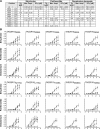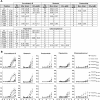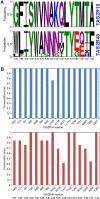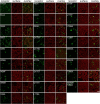The human bitter taste receptor TAS2R10 is tailored to accommodate numerous diverse ligands
- PMID: 23283334
- PMCID: PMC6618634
- DOI: 10.1523/JNEUROSCI.3248-12.2013
The human bitter taste receptor TAS2R10 is tailored to accommodate numerous diverse ligands
Abstract
Bitter taste is a basic taste modality, required to safeguard animals against consuming toxic substances. Bitter compounds are recognized by G-protein-coupled bitter taste receptors (TAS2Rs). The human TAS2R10 responds to the toxic strychnine and numerous other compounds. The mechanism underlying the development of the broad tuning of some TAS2Rs is not understood. Using comparative modeling, site-directed mutagenesis, and functional assays, we identified residues involved in agonist-induced activation of TAS2R10, and investigated the effects of different substitutions on the receptor's response profile. Most interestingly, mutations in S85(3.29) and Q175(5.40) have differential impact on stimulation with different agonists. The fact that single point mutations lead to improved responses for some agonists and to decreased activation by others indicates that the binding site has evolved to optimally accommodate multiple agonists at the expense of reduced potency. TAS2R10 shares the agonist strychnine with TAS2R46, another broadly tuned receptor. Engineering the key determinants for TAS2R46 activation by strychnine in TAS2R10 caused a loss of response to strychnine, indicating that these paralog receptors display different strychnine-binding modes, which suggests independent acquisition of agonist specificities. This implies that the gene duplication event preceding primate speciation was accompanied by independent evolution of the strychnine-binding sites.
Figures









Similar articles
-
Reengineering the ligand sensitivity of the broadly tuned human bitter taste receptor TAS2R14.Biochim Biophys Acta Gen Subj. 2018 Oct;1862(10):2162-2173. doi: 10.1016/j.bbagen.2018.07.009. Epub 2018 Jul 19. Biochim Biophys Acta Gen Subj. 2018. PMID: 30009876
-
Genetic mutation of Tas2r104/Tas2r105/Tas2r114 cluster leads to a loss of taste perception to denatonium benzoate and cucurbitacin B.Animal Model Exp Med. 2024 Jun;7(3):324-336. doi: 10.1002/ame2.12357. Epub 2023 Dec 28. Animal Model Exp Med. 2024. PMID: 38155461 Free PMC article.
-
Broad tuning of the human bitter taste receptor hTAS2R46 to various sesquiterpene lactones, clerodane and labdane diterpenoids, strychnine, and denatonium.J Agric Food Chem. 2007 Jul 25;55(15):6236-43. doi: 10.1021/jf070503p. Epub 2007 Jun 27. J Agric Food Chem. 2007. PMID: 17595105
-
Elucidation of mammalian bitter taste.Rev Physiol Biochem Pharmacol. 2005;154:37-72. doi: 10.1007/s10254-005-0041-0. Rev Physiol Biochem Pharmacol. 2005. PMID: 16032395 Review.
-
Bitter taste receptors and human bitter taste perception.Cell Mol Life Sci. 2006 Jul;63(13):1501-9. doi: 10.1007/s00018-006-6113-8. Cell Mol Life Sci. 2006. PMID: 16732425 Free PMC article. Review.
Cited by
-
A natural point mutation in the bitter taste receptor TAS2R16 causes inverse agonism of arbutin in lemur gustation.Proc Biol Sci. 2019 Jun 12;286(1904):20190884. doi: 10.1098/rspb.2019.0884. Epub 2019 Jun 5. Proc Biol Sci. 2019. PMID: 31161904 Free PMC article.
-
BitterMatch: recommendation systems for matching molecules with bitter taste receptors.J Cheminform. 2022 Jul 7;14(1):45. doi: 10.1186/s13321-022-00612-9. J Cheminform. 2022. PMID: 35799226 Free PMC article.
-
Sequence Analysis of Bitter Taste Receptor Gene Repertoires in Different Ruminant Species.PLoS One. 2015 Jun 10;10(6):e0124933. doi: 10.1371/journal.pone.0124933. eCollection 2015. PLoS One. 2015. PMID: 26061084 Free PMC article.
-
Snooker structure-based pharmacophore model explains differences in agonist and blocker binding to bitter receptor hTAS2R39.PLoS One. 2015 Mar 2;10(3):e0118200. doi: 10.1371/journal.pone.0118200. eCollection 2015. PLoS One. 2015. PMID: 25729848 Free PMC article.
-
Structure-Function Analyses of Human Bitter Taste Receptors-Where Do We Stand?Molecules. 2020 Sep 26;25(19):4423. doi: 10.3390/molecules25194423. Molecules. 2020. PMID: 32993119 Free PMC article. Review.
References
-
- Adler E, Hoon MA, Mueller KL, Chandrashekar J, Ryba NJ, Zuker CS. A novel family of mammalian taste receptors. Cell. 2000;100:693–702. - PubMed
-
- Ballesteros J, Weinstein H. Integrated methods for the construction of three-dimensional models of structure–function relations in G-protein-coupled receptors. Methods Neurosci. 1995;25:366–428.
-
- Behrens M, Brockhoff A, Kuhn C, Bufe B, Winnig M, Meyerhof W. The human taste receptor hTAS2R14 responds to a variety of different bitter compounds. Biochem Biophys Res Commun. 2004;319:479–485. - PubMed
-
- Behrens M, Bartelt J, Reichling C, Winnig M, Kuhn C, Meyerhof W. Members of RTP and REEP gene families influence functional bitter taste receptor expression. J Biol Chem. 2006;281:20650–20659. - PubMed
Publication types
MeSH terms
Substances
LinkOut - more resources
Full Text Sources
Other Literature Sources
Molecular Biology Databases
